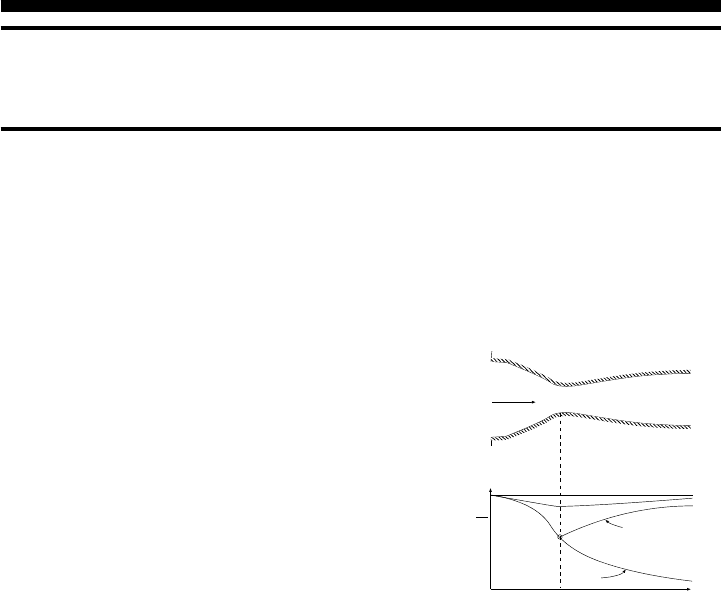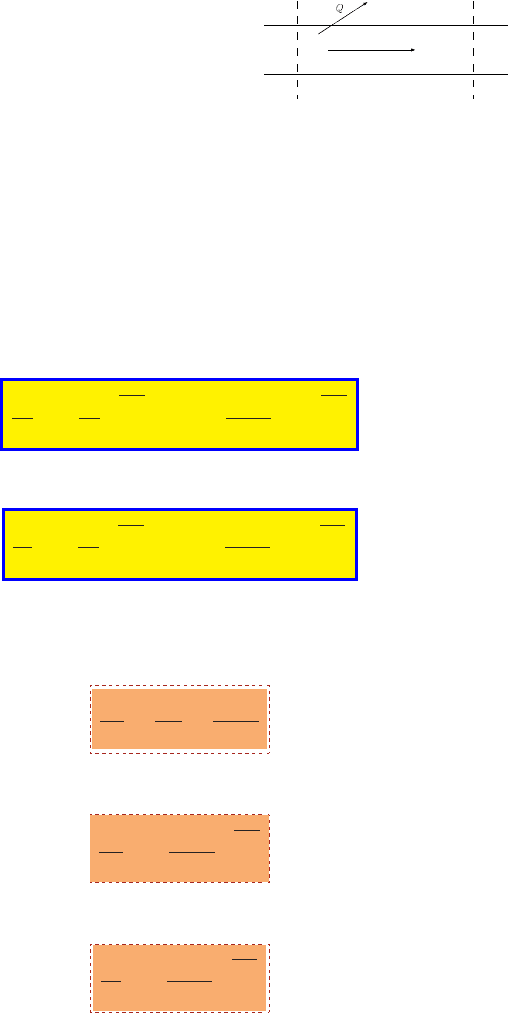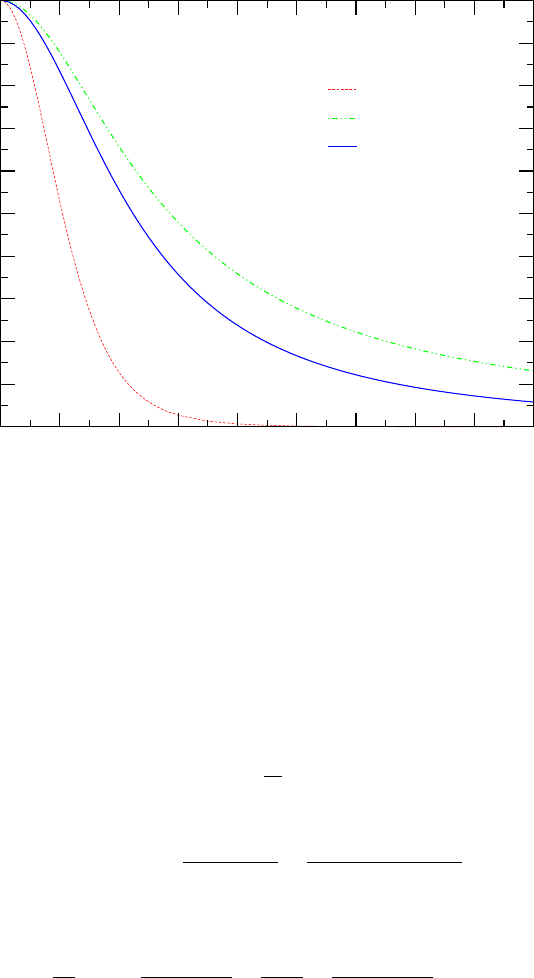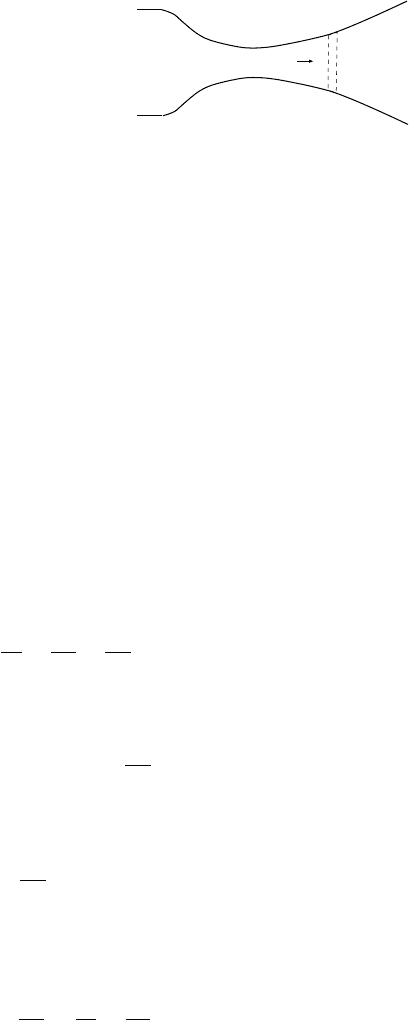Bar-Meir G. Fundamentals of Compressible Fluid
Подождите немного. Документ загружается.


4.7. SOUND SPEED IN TWO PHASE MEDIUM 51
A approximation of addition droplets of liquid or dust (solid) results in reduction of R
and yet approximate equation similar to ideal gas was obtained. It must noticed that
m = constant. If the droplets (or the solid particles) can be assumed to have the
same velocity as the gas with no heat transfer or fiction between the particles isentropic
relation can be assumed as
P
ρ
a
k
= constant (4.46)
Assuming that partial pressure of the particles is constant and applying the second law
for the mixture yields
0 =
dropl ets
z }| {
mC
dT
T
+
g as
z }| {
C
p
dT
T
− R
dP
P
=
(C
p
+ mC)dT
T
− R
dP
P
(4.47)
Therefore, the mixture isentropic relationship can be expressed as
P
γ−1
γ
T
= constant (4.48)
where
γ − 1
γ
=
R
C
p
+ mC
(4.49)
Recalling that R = C
p
− C
v
reduces equation (4.49) into
γ =
C
p
+ mC
C
v
+ mC
(4.50)
In a way the definition of γ was so chosen that effective specific pressure heat and
effective specific volumetric heat are
C
p
+mC
1+m
and
C
v
+mC
1+m
respectively. The correction
factors for the specific heat is not linear.
Since the equations are the same as before hence the familiar equation for speed
of sound can be applied as
c =
p
γR
mix
T
(4.51)
It can be noticed that R
mix
and γ are smaller than similar variables in a pure gas.
Hence, this analysis results in lower speed of sound compared to pure gas. Generally, the
velocity of mixtures with large gas component is smaller of the pure gas. For example,
the velocity of sound in slightly wet steam can be about one third of the pure steam
speed of sound.

52 CHAPTER 4. SPEED OF SOUND
Meta
For a mixture of two phases, speed of sound can be expressed as
c
2
=
∂P
∂ρ
=
∂P [f(X)]
∂ρ
(4.52)
where X is defined as
X =
s −s
f
(P
B
)
s
fg
(P
B
)
(4.53)
Meta End

CHAPTER 5
Isentropic Flow
distance, x
P
P
0
P
B
= P
0
M > 1
Supersonic
Subsonic
M < 1
Fig. -5.1. Flow of a compressible sub-
stance (gas) through a converging–
diverging nozzle.
In this chapter a discussion on a steady state flow
through a smooth and continuous area flow rate
is presented. A discussion about the flow through
a converging–diverging nozzle is also part of this
chapter. The isentropic flow models are important
because of two main reasons: One, it provides the
information about the trends and important pa-
rameters. Two, the correction factors can be in-
troduced later to account for deviations from the
ideal state.
5.1 Stagnation State for Ideal Gas
Model
5.1.1 General Relationship
It is assumed that the flow is one–dimensional. Figure (5.1) describes a gas flow through
a converging–diverging nozzle. It has been found that a theoretical state known as
the stagnation state is very useful in simplifying the solution and treatment of the flow.
The stagnation state is a theoretical state in which the flow is brought into a complete
motionless condition in isentropic process without other forces (e.g. gravity force).
Several properties that can be represented by this theoretical process which include
temperature, pressure, and density et cetera and denoted by the subscript “0.”
First, the stagnation temperature is calculated. The energy conservation can
53

54 CHAPTER 5. ISENTROPIC FLOW
be written as
h +
U
2
2
= h
0
(5.1)
Perfect gas is an ideal gas with a constant heat capacity, C
p
. For perfect gas equation
(5.1) is simplified into
C
p
T +
U
2
2
= C
p
T
0
(5.2)
Again it is common to denote T
0
as the stagnation temperature. Recalling from
thermodynamic the relationship for perfect gas
R = C
p
− C
v
(5.3)
and denoting k ≡ C
p
÷ C
v
then the thermodynamics relationship obtains the form
C
p
=
kR
k − 1
(5.4)
and where R is a specific constant. Dividing equation (5.2) by (C
p
T ) yields
1 +
U
2
2C
p
T
=
T
0
T
(5.5)
Now, substituting c
2
= kRT or T = c
2
/kR equation (5.5) changes into
1 +
kRU
2
2C
p
c
2
=
T
0
T
(5.6)
By utilizing the definition of k by equation (2.24) and inserting it into equation (5.6)
yields
1 +
k − 1
2
U
2
c
2
=
T
0
T
(5.7)
It very useful to convert equation (5.6) into a dimensionless form and denote
Mach number as the ratio of velocity to speed of sound as
M ≡
U
c
(5.8)
Inserting the definition of Mach number (5.8) into equation (5.7) reads
T
0
T
= 1 +
k − 1
2
M
2
(5.9)

5.1. STAGNATION STATE FOR IDEAL GAS MODEL 55
velocity
T
0
A
B
P
0
ρ
0
T
0
P
0
ρ
0
Fig. -5.2. Perfect gas flows through a tube
The usefulness of Mach number and
equation (5.9) can be demonstrated by this fol-
lowing simple example. In this example a gas
flows through a tube (see Figure 5.2) of any
shape can be expressed as a function of only
the stagnation temperature as opposed to the
function of the temperatures and velocities.
The definition of the stagnation state
provides the advantage of compact writing. For example, writing the energy equation
for the tube shown in Figure (5.2) can be reduced to
˙
Q = C
p
(T
0
B
− T
0
A
) ˙m (5.10)
The ratio of stagnation pressure to the static pressure can be expressed as the
function of the temperature ratio because of the isentropic relationship as
P
0
P
=
µ
T
0
T
¶
k
k−1
=
µ
1 +
k − 1
2
M
2
¶
k
k−1
(5.11)
In the same manner the relationship for the density ratio is
ρ
0
ρ
=
µ
T
0
T
¶
1
k−1
=
µ
1 +
k − 1
2
M
2
¶
1
k−1
(5.12)
A new useful definition is introduced for the case when M = 1 and denoted by
superscript “∗.” The special case of ratio of the star values to stagnation values are
dependent only on the heat ratio as the following:
T
∗
T
0
=
c
∗
2
c
0
2
=
2
k + 1
(5.13)
P
∗
P
0
=
µ
2
k + 1
¶
k
k−1
(5.14)
ρ
∗
ρ
0
=
µ
2
k + 1
¶
1
k−1
(5.15)

56 CHAPTER 5. ISENTROPIC FLOW
0 1 2 3 4
5 6
7
8 9
Mach number
0
0.1
0.2
0.3
0.4
0.5
0.6
0.7
0.8
0.9
1
P/P
0
ρ/ρ
0
T/T
0
Static Properties As A Function of Mach Number
Mon Jun 5 17:39:34 2006
Fig. -5.3. The stagnation properties as a function of the Mach number, k = 1.4
5.1.2 Relationships for Small Mach Number
Even with today’s computers a simplified method can reduce the tedious work involved in
computational work. In particular, the trends can be examined with analytical methods.
It further will be used in the bo ok to examine trends in derived models. It can be noticed
that the Mach number involved in the above equations is in a square power. Hence, if
an acceptable error is of about %1 then M < 0.1 provides the desired range. Further, if
a higher power is used, much smaller error results. First it can be noticed that the ratio
of temperature to stagnation temperature,
T
T
0
is provided in power series. Expanding
of the equations according to the binomial expansion of
(1 + x)
n
= 1 + nx +
n(n −1)x
2
2!
+
n(n −1)(n − 2)x
3
3!
+ ··· (5.16)
will result in the same fashion
P
0
P
= 1 +
(k − 1)M
2
4
+
kM
4
8
+
2(2 −k)M
6
48
··· (5.17)

5.2. ISENTROPIC CONVERGING-DIVERGING FLOW IN CROSS SECTION 57
ρ
0
ρ
= 1 +
(k − 1)M
2
4
+
kM
4
8
+
2(2 −k)M
6
48
··· (5.18)
The pressure difference normalized by the velocity (kinetic energy) as correction factor
is
P
0
− P
1
2
ρU
2
= 1 +
compressibil ity correction
z }| {
M
2
4
+
(2 −k)M
4
24
+ ··· (5.19)
From the above equation, it can be observed that the correction factor approaches
zero when M −→ 0 and then equation (5.19) approaches the standard equation for
incompressible flow.
The definition of the star Mach is ratio of the velocity and star speed of sound
at M = 1.
M
∗
=
U
c
∗
=
r
k + 1
2
M
µ
1 −
k − 1
4
M
2
+ ···
¶
(5.20)
P
0
− P
P
=
kM
2
2
µ
1 +
M
2
4
+ ···
¶
(5.21)
ρ
0
− ρ
ρ
=
M
2
2
µ
1 −
kM
2
4
+ ···
¶
(5.22)
The normalized mass rate becomes
˙m
A
=
s
kP
0
2
M
2
RT
0
µ
1 +
k − 1
4
M
2
+ ···
¶
(5.23)
The ratio of the area to star area is
A
A
∗
=
µ
2
k + 1
¶
k+1
2(k−1)
µ
1
M
+
k + 1
4
M +
(3 −k)(k + 1)
32
M
3
+ ···
¶
(5.24)
5.2 Isentropic Converging-Diverging Flow in Cross Section

58 CHAPTER 5. ISENTROPIC FLOW
T
ρ
P
U
T+dT
ρ+dρ
P+dP
U+dU
Fig. -5.4. Control volume inside a converging-
diverging nozzle.
The important sub case in this chapter
is the flow in a converging–diverging noz-
zle. The control volume is shown in Fig-
ure (5.4). There are two models that as-
sume variable area flow: First is isentropic
and adiabatic model. Second is isentropic
and isothermal model. Clearly, the stagna-
tion temperature, T
0
, is constant through
the adiabatic flow because there isn’t heat
transfer. Therefore, the stagnation pres-
sure is also constant through the flow because the flow isentropic. Conversely, in
mathematical terms, equation (5.9) and equation (5.11) are the same. If the right hand
side is constant for one variable, it is constant for the other. In the same argument, the
stagnation density is constant through the flow. Thus, knowing the Mach number or
the temperature will provide all that is needed to find the other properties. The only
properties that need to be connected are the cross section area and the Mach number.
Examination of the relation between properties can then be carried out.
5.2.1 The Properties in the Adiabatic Nozzle
When there is no external work and heat transfer, the energy equation, reads
dh + U dU = 0 (5.25)
Differentiation of continuity equation, ρAU = ˙m = constant, and dividing by the
continuity equation reads
dρ
ρ
+
dA
A
+
dU
U
= 0 (5.26)
The thermodynamic relationship between the properties can be expressed as
T ds = dh −
dP
ρ
(5.27)
For isentropic process ds ≡ 0 and combining equations (5.25) with (5.27) yields
dP
ρ
+ UdU = 0 (5.28)
Differentiation of the equation state (perfect gas), P = ρRT , and dividing the results
by the equation of state (ρRT ) yields
dP
P
=
dρ
ρ
+
dT
T
(5.29)

5.2. ISENTROPIC CONVERGING-DIVERGING FLOW IN CROSS SECTION 59
Obtaining an expression for dU/U from the mass balance equation (5.26) and using it
in equation (5.28) reads
dP
ρ
− U
2
dU
U
z }| {
·
dA
A
+
dρ
ρ
¸
= 0 (5.30)
Rearranging equation (5.30) so that the density, ρ, can be replaced by the static
pressure, dP/ρ yields
dP
ρ
= U
2
µ
dA
A
+
dρ
ρ
dP
dP
¶
= U
2
dA
A
+
1
c
2
z}|{
dρ
dP
dP
ρ
(5.31)
Recalling that dP/dρ = c
2
and substitute the speed of sound into equation (5.31) to
obtain
dP
ρ
"
1 −
µ
U
c
¶
2
#
= U
2
dA
A
(5.32)
Or in a dimensionless form
dP
ρ
¡
1 −M
2
¢
= U
2
dA
A
(5.33)
Equation (5.33) is a differential equation for the pressure as a function of the cross sec-
tion area. It is convenient to rearrange equation (5.33) to obtain a variables separation
form of
dP =
ρU
2
A
dA
1 −M
2
(5.34)
The pressure Mach number relationship
Before going further in the mathematical derivation it is worth looking at the physical
meaning of equation (5.34). The term ρU
2
/A is always positive (because all the three
terms can be only positive). Now, it can be observed that dP can be positive or
negative depending on the dA and Mach number. The meaning of the sign change for
the pressure differential is that the pressure can increase or decrease. It can be observed
that the critical Mach number is one. If the Mach number is larger than one than dP
has opposite sign of dA . If Mach number is smaller than one dP and dA have the same
sign. For the subsonic branch M < 1 the term 1/(1 − M
2
) is positive hence
dA > 0 =⇒ dP > 0
dA < 0 =⇒ dP < 0

60 CHAPTER 5. ISENTROPIC FLOW
From these observations the trends are similar to those in incompressible fluid. An
increase in area results in an increase of the static pressure (converting the dynamic
pressure to a static pressure). Conversely, if the area decreases (as a function of x)
the pressure decreases. Note that the pressure decrease is larger in compressible flow
compared to incompressible flow.
For the supersonic branch M > 1, the phenomenon is different. For M > 1
the term 1/1 − M
2
is negative and change the character of the equation.
dA > 0 ⇒ dP < 0
dA < 0 ⇒ dP > 0
This behavior is opposite to incompressible flow behavior.
For the special case of M = 1 (sonic flow) the value of the term 1 − M
2
= 0
thus mathematically dP → ∞ or dA = 0. Since physically dP can increase only in
a finite amount it must that dA = 0.It must also be noted that when M = 1 occurs
only when dA = 0. However, the opposite, not necessarily means that when dA = 0
that M = 1. In that case, it is possible that dM = 0 thus the diverging side is in the
subsonic branch and the flow isn’t choked.
The relationship between the velocity and the pressure can be observed from
equation (5.28) by solving it for dU.
dU = −
dP
P U
(5.35)
From equation (5.35) it is obvious that dU has an opposite sign to dP (since the term
P U is positive). Hence the pressure increases when the velocity decreases and vice
versa.
From the speed of sound, one can observe that the density, ρ, increases with
pressure and vice versa (see equation 5.36).
dρ =
1
c
2
dP (5.36)
It can be noted that in the derivations of the above equations (5.35 - 5.36), the
equation of state was not used. Thus, the equations are applicable for any gas (perfect
or imperfect gas).
The second law (isentropic relationship) dictates that ds = 0 and from ther-
modynamics
ds = 0 = C
p
dT
T
− R
dP
P
and for perfect gas
dT
T
=
k − 1
k
dP
P
(5.37)
Thus, the temperature varies according to the same way that pressure does.
